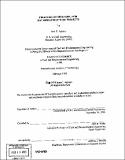Financial engineering for BOT infrastructure projects
Author(s)
Aguayo, Juan C. (Juan Carlos), 1964-
DownloadFull printable version (15.17Mb)
Alternative title
Financial engineering for build-operate-transfer infrastructure projects
Advisor
John B. Miller.
Terms of use
Metadata
Show full item recordAbstract
The implementation of the Build-Operate-Transfer (BOT) model for the provision of infrastructure facilities in the United States constitutes a paradigm shift, and a recent innovation, in the delivery and financing of these socially and economically important projects. The main justification, for incorporating the BOT strategy as an alternative in the development of new infrastructure facilities, is the need to access private capital to leverage the insufficient government funds for the financing of these massive undertakings. A key factor contributing to the sustainability of the BOT approach as a viable procurement strategy for infrastructure projects, and providing a decisive competitive advantage to prospective private sector respondents interested in pursuing these ventures, is the expertise in financial engineering. As defined in this thesis, financial engineering is the systematic process that enables a private company to decide first in which BOT project to invest, and then to design the most cost-effective funding structure for financing the venture. This thesis proposes a formal procedure for the financial engineering and modeling of BOT infrastructure projects. Financial modeling, the cornerstone of the financial engineering process, involves the development of simplified scenarios, analytical tools and techniques that enable the objective evaluation of the economic attractiveness and financial viability of a BOT venture. After outlining the steps within the suggested financial modeling framework, a case study consisting of the Canada Confederation Bridge Project is presented. Acknowledging that the recommended financial models for BOT infrastructure projects are simplified illustrations of mammoth and complicated construction programs, this thesis also investigated some of the most important issues Associated with these types of investments to complement the quantitative analyses. This was accomplished through a literature review, and four mini case studies consisting of recent projects in the United States.
Description
Thesis (S.M.)--Massachusetts Institute of Technology, Dept. of Civil and Environmental Engineering, February 1999. Includes bibliographical references (leaves 224-228).
Date issued
1999Department
Massachusetts Institute of Technology. Department of Civil and Environmental EngineeringPublisher
Massachusetts Institute of Technology
Keywords
Civil and Environmental Engineering